#cancer productus
Text

world's bravest crab
#Like#these ladies have been all but swallowing them for that strip of salmon bacon he's defending#and yet he charges#braver than the marines#shitpost#meme#crab#crustacean#hexanchus griseus#bluntnose sixgill shark#red rock crab#cancer productus#shark
265 notes
·
View notes
Photo

Today's Crab is: Quite polite!
(Red Rock Crab, Cancer productus)
196 notes
·
View notes
Note
Crustacurary crustation auryray crustday thursday crust day Cancer productus
Holy shit dude are you alright
50 notes
·
View notes
Photo
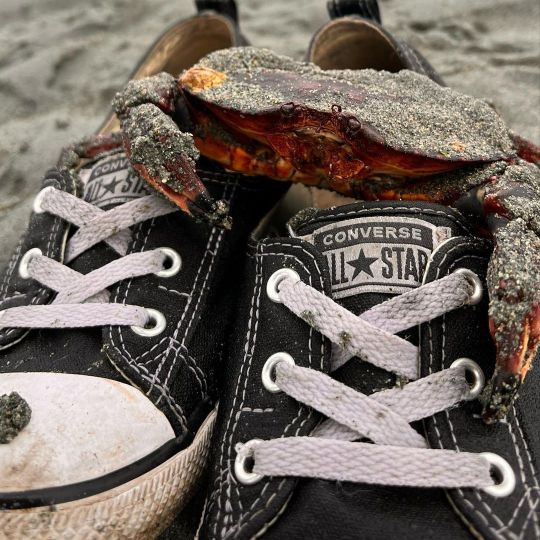
If all #models were this cooperative, I would be happy to use them in my photography. Red Rco Crab (Cancer productus) #redrockcrab #cancerproductus #marinebiology #crustaceans #converseallstar #chucktaylor #beach #sand #crab @parksvillequalicumbeach @converse (at Parksville Comunity beach) https://www.instagram.com/p/CgIJ_eOvMlB/?igshid=NGJjMDIxMWI=
#models#redrockcrab#cancerproductus#marinebiology#crustaceans#converseallstar#chucktaylor#beach#sand#crab
1 note
·
View note
Photo



Colors of the California coast Fort Funston, CA: Sea palms (Postelsia palmaeformis), Pacific sand crab (Emerita analoga) carapace, Red Rock crab (Cancer productus) carapace
#can't get over these colors#esp on the rock crab#and the sand crab!!!#my art#my photos#ocean pictures#sea life#marine life#crab#ocean aesthetic#beach#shoreline#beach aesthetic#kelp#ocean photography#ocean life#invertebrates#algae#sandy beach#scouts art#photography
66 notes
·
View notes
Photo


A beautiful red rock crab [Cancer productus] found and photographed in Monterey County, California. Images by Gary McDonald.
104 notes
·
View notes
Photo

@JHelminthology: This study found that the red rock crab (Cancer productus) 🦀 and Pacific rock crab (Romaleon antennarium) 🦀 serve as intermediate hosts for the trematode fluke Helicometrina nimia - a parasite which infects fish as their final host 🐟 https://t.co/0pKjAY4N4a https://t.co/Z3x7xNt1Wr
0 notes
Photo

Cancer productus - also called the red rock crab, because it is red and it lives on rocks. Their genus originated in the earliest Neogene and is still alive today. They can be found along the western coast of North America, where they hang out and eat barnacles.
Ꞓ - O - S - D - C - P - T - J - K - Pg - N
Image Credit: R. Grimes 2015
17 notes
·
View notes
Photo

Elise Granek and Catherine de Rivera, Environmental Science and Management faculty coauthored “Prozac in the water: Chronic fluoxetine exposure and predation risk interact to shape behaviors in an estuarine crab,” published in Ecology and Evolution, September 2017, DOI: 10.1002/ece3.3453
Abstract: Predators exert considerable top-down pressure on ecosystems by directly consuming prey or indirectly influencing their foraging behaviors and habitat use. Prey is, therefore, forced to balance predation risk with resource reward. A growing list of anthropogenic stressors such as rising temperatures and ocean acidification has been shown to influence prey risk behaviors and subsequently alter important ecosystem processes. Yet, limited attention has been paid to the effects of chronic pharmaceutical exposure on risk behavior or as an ecological stressor, despite widespread detection and persistence of these contaminants in aquatic environments. In the laboratory, we simulated estuarine conditions of the shore crab, Hemigrapsus oregonensis, and investigated whether chronic exposure (60 days) to field-detected concentrations (0, 3, and 30 ng/L) of the antidepressant fluoxetine affected diurnal and nocturnal risk behaviors in the presence of a predator, Cancer productus. We found that exposure to fluoxetine influenced both diurnal and nocturnal prey risk behaviors by increasing foraging and locomotor activity in the presence of predators, particularly during the day when these crabs normally stay hidden. Crabs exposed to fluoxetine were also more aggressive, with a higher frequency of agonistic interactions and increased mortality due to conflicts with conspecifics. These results suggest that exposure to field-detected concentrations of fluoxetine may alter the trade-off between resource acquisition and predation risk among crabs in estuaries. This fills an important data gap, highlighting how intra- and interspecific behaviors are altered by exposure to field concentrations of pharmaceuticals; such data more explicitly identify potential ecological impacts of emerging contaminants on aquatic ecosystems and can aid water quality management.
Prozac in the water: Chronic fluoxetine exposure and predation risk interact to shape behaviors in an estuarine crab. Available from: https://www.researchgate.net/publication/320133543_Prozac_in_the_water_Chronic_fluoxetine_exposure_and_predation_risk_interact_to_shape_behaviors_in_an_estuarine_crab [accessed Oct 4, 2017].
#portland state university#portlandstateresearch#psuresearch#psuclas#psuenvironmentalscienceandmanagement
0 notes
Photo

Talk about a crab-tivating new friend, and one that fits in the palm of your hand! Just watch out for its claws if it's feeling crabby. 🦀🦀
This little juvenile red rock crab (Cancer productus) was picked up out of some algae during a research expedition in Greater Farallones National Marine Sanctuary. In adulthood, red rock crabs are, indeed, brick red, but when they're this young they can be a variety of colors and patterns.
(Photo: Mojoscoast/ACCESS/NOAA/Pt. Blue/R. Wallen)
[Image description: A small white crab with brown stripes in the palm of a person's hand.]
#🦀#crab#cancer productus#red rock crab#crustacean#ocean#nature#tiny#wee#noaa#Greater Farallones National Marine Sanctuary#earthisblue
124 notes
·
View notes
Photo
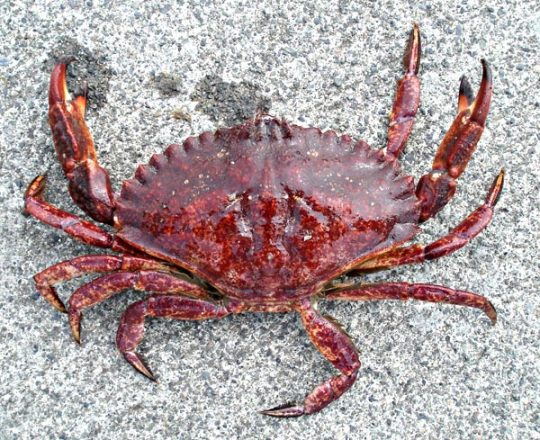

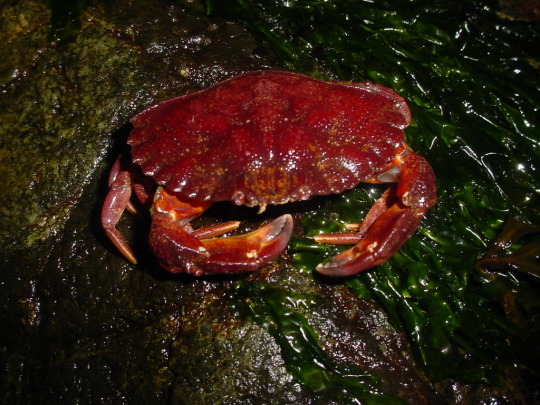

Cancer productus
Cancer productus, one of several species known as red rock crabs, is a crab of the genus Cancer found on the western coast of North America. Cancer productus is carnivorous; in Puget Sound it will crush barnacles with its large pincers for consumption. Small living crabs and dead fish are also eaten.
photo credits: wiki, Kirt L. Onthank, Dave Cowles, mexfish
#cancer productus#rock crab#crab#zoology#biodiversity#biology#science#wildlife#nature#animals#cool critters
132 notes
·
View notes
Photo

making merriment from misery
#red rock crab#cancer productus#graceful crab#metacarcinus gracilis#MaST Center aquarium#shitpost#meme#marine biology
217 notes
·
View notes
Photo
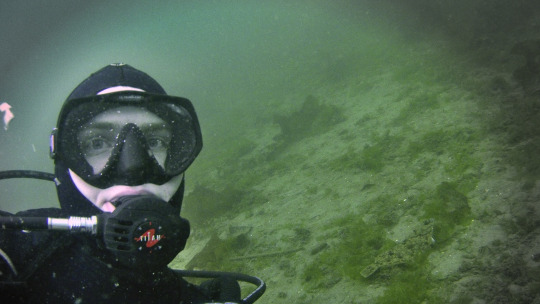

Shellfies with a handsome rock sole (Lepidopsetta bilineata) and a red rock crab (Cancer productus)
#cancer productus#red rock crab#lepidopsetta bilineata#rock sole#flatfish#crab#brachyura#cancridae#pleuronectodae#puget sound#pnw#whulge#underwater photography#scuba#diving#wa#washington#marine biology#tacoma#les davis#salish sea
101 notes
·
View notes
Photo
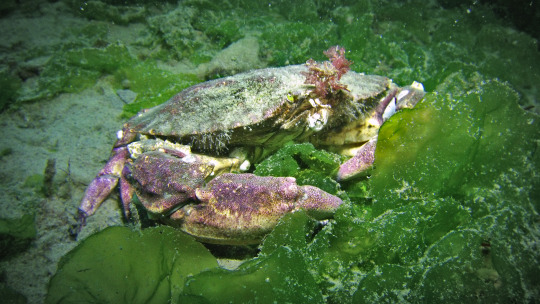
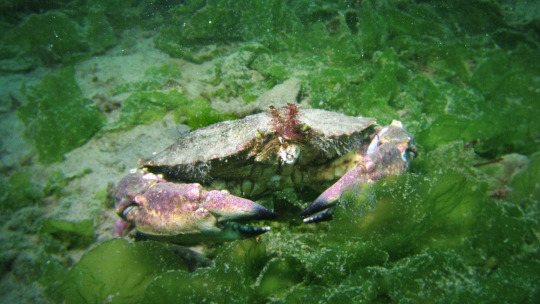

Red Rock Crab (Cancer productus)
#cancer productus#red rock crab#brachyura#cancridae#underwater#photography#scuba#diving#pnw#wa#washington#les davis#tacoma#ocean#marine biology#crab#crustacean#whulge#salish sea
81 notes
·
View notes
Text

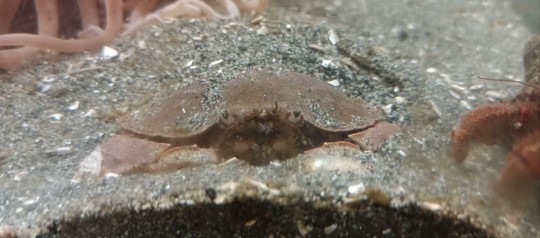
Our Cancer productus and one of our Metacarcinus gracilis. Cozy as a crab!!!! 🦀 🛏️
#mast center aquarium#graceful crab#red rock crab#cancer productus#metacarcinus gracilis#crab#crustacean#decapod#brachyura#cancridae
20 notes
·
View notes
Text
youtube
INCREDIBLE new footage from John Sanders at Redondo!!!
Here's why:
The question is up in the air as to whether the bluntnose sixgill shark (Hexanchus griseus) is a primarily a predator or scavenger. The answer is likely both when looking at other predators in its niche, but this footage is another key to confirming the hypothesis that they are primarily scavengers.
In the past, H. griseus has been recorded ingesting crabs and spitting them out at a bait station specifically for the crabs. This was interesting to me because crustaceans supposedly make up a decent portion of their diet. Why wouldn't the observed shark eat the crabs even if it couldn't get the fish meat inside the trap?
A more recent study, which I also wrote about, found tissues from a young dolphin in the stomach of an H. griseus from the western Mediterranean Sea. These are not fast sharks. There were not brittle stars or other scavenging organisms in the stomach, suggesting that the shark got to the dolphin before the others, if it was scavenged and not predated. Among other little details that I go into further detail in that post.
To the point: In this video, we see three H. griseus at a bait station crowded with pacific spiny dogfish (Squalus suckleyi) and red rock crabs (Cancer productus). There was one Dungeness crab (Metacarcinus magister) and one flatfish that may be a rock sole (Lepidopsetta bilineata) or an English sole (Parophrys vetulus). All gathered to feed on the salmon meat placed by the divers. Repeatedly in the footage, we see the H. griseus ingest crabs and spit them out alive.
Why? Well, it appears that they are only interested in the salmon flesh and may have been trying to steal the morsels that the crabs were pinching away at. In one instance, an H. griseus goes for a whole gathering of crabs. Doesn't eat a single one. Now, to draw any conclusion from this would require a lot of assumptions. I assume that these crabs had salmon meat in their claws and I assume that the sharks got the flesh before spitting the crabs out. That need not be the case to still support my hypothesis that these sharks are primarily scavengers.
These sharks had multiple opportunities to eat any number of the other visitors to the feast. In one moment, an S. suckleyi was right at the rostrum of one of the H. griseus and the latter didn't even try to eat the former. This could be because S. suckleyi has venomous spines; perhaps it is learned or instinctual not to try and eat them. But then there's the C. productus. Other that having a slippery carapace, there is little the crab could do that would prove fatal if eaten live. And then there's the flatfish, which has no natural defenses or hazards.
All of this points to scavenger behavior.
I am blown away by this footage (and extremely envious of this diver). Even though my ROV is OOC, I still get observe these sharks in one way or another.
#eukarya#animalia#chordates#chondrichthyes#elasmobranchs#selachimorpha#hexanchiformes#hexanchidae#hexanchus griseus#h. griseus#c. productus#cancer productus#red rock crab#metacarcinus magister#m. magister#dungeness crab#pacific spiny dogfish#squalus suckleyi#s. suckleyi#english sole#parophrys vetulus#p. vetulus#rock sole#northern rock sole#southern rock sole#lepidopsetta bilineata#l. bilineata#john sanders#redondo#wa
9 notes
·
View notes